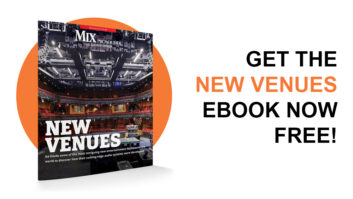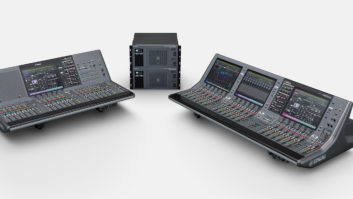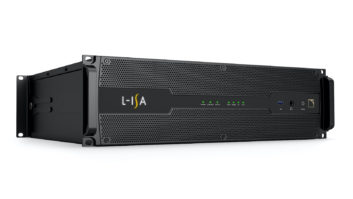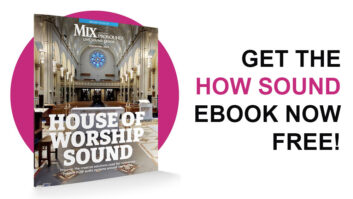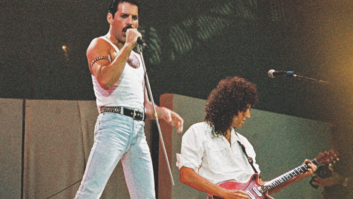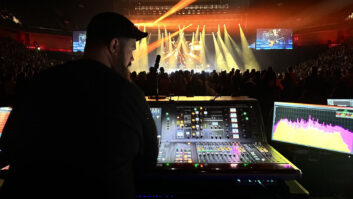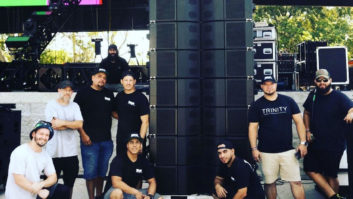It’s hard to believe it’s been nearly 15 years since Linkin Park broke out with its debut, Hybrid Theory, but 60 million albums later, the band’s shape-shifting mix of hard rock, hip-hop and electronica remains as eclectic and accessible as ever. Case in point: The Hunting Party— the band’s latest album that came out this past summer.
In January, Linkin Park kicks off the next U.S. leg of the world tour supporting its latest album, The Hunting Party. While the group is touring the world in support of the back-to-basics collection, the audio systems in tow are anything but old-fashioned. In fact, everything from the FOH and monitor mix positions to the on-stage network used by Linkin Park itself is cutting-edge.
“In January, we met with the band and talked about a full-on audio upgrade from what we’d been using,” said longtime FOH engineer Ken “Pooch” Van Druten. The band wanted to expand the number of tracks it used on stage and have 128 inputs available if needed. “I had 96 and it was not enough,” said Pooch. “Our setup on an average show is about 80 inputs, but they do crazy things sometimes, like have a choir come in and a marching band. We literally have 20 inputs that are set aside for when they do stuff like that. So I only had 96 here, and while the monitor desk could do 128, it didn’t have enough outputs anymore. On top of all that, we all wanted to have a 96 kHz solution as opposed to 48 kHz.”
The end result was that Pooch and monitor engineer Kevin “Tater” McCarthy each bought their own DiGiCo SD7 consoles and respective mix position equipment, and now rent them back to the band. “It was a major investment,” Pooch conceded. “You’ve got to buy all the bells and whistles, so we got things like an Antelope Isochrone 10M atomic clock—it adds up, but it makes a difference. We both agree we’ve significantly improved the audio quality of Linkin Park by doing this. I find I EQ less and if you look down most of my inputs, there’s just high pass filters and small cuts and boosts here and there—not a whole lot. We’re pretty pleased with what’s going on.”
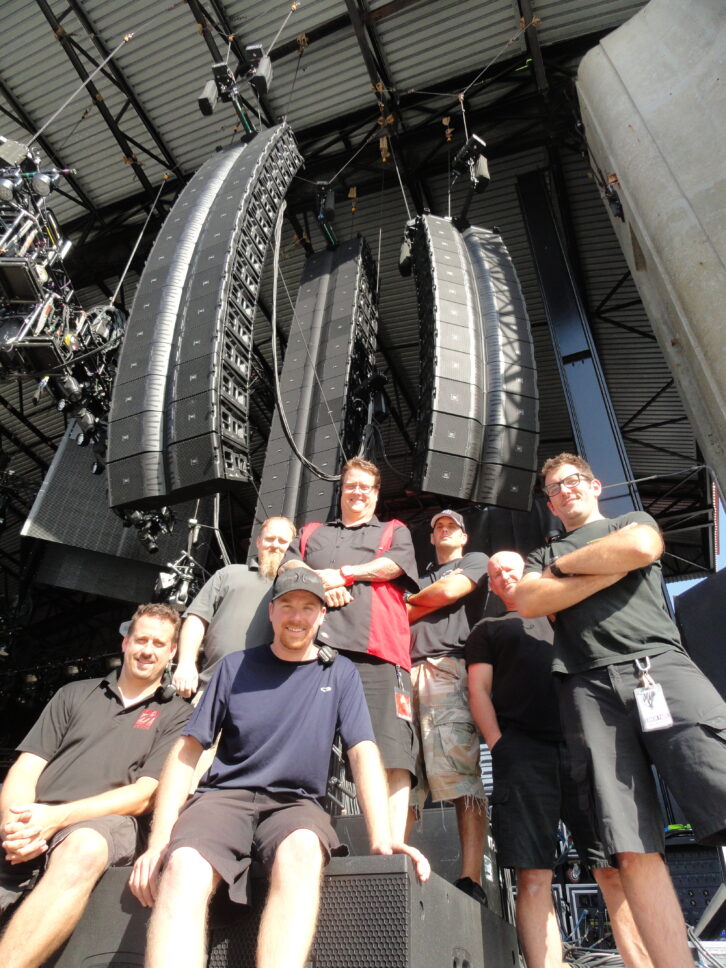
Both Pooch and Tater make use of a Waves SoundGrid Server for their plug-ins, with Pooch leaning on favorites like the L2 Ultramaximizer Peak Limiter, C6 Multiband Compressor and Renaissance Axx. Each show is recorded at 96 kHz to main- and backup multi-tracks via four MADI streams exiting the console into four DiGiGrid MGB interfaces (two main, two redundant) connected to Mac Minis recording in an open-source DAW, Reaper by Cockos. “I bought the commercial version which is $200, and literally, you can record 128 tracks and surf the web—it’s just solid,” said Pooch.
Both the FOH and monitor desks share the same SD Rack system— four SD Rack units on an Optocore loop. Pooch explained, “There’s no splitter, so from the stage racks where we’re converting, it’s digital all the way to the amps, right before the speakers.” The PA in question is a considerable JBL VTX line array system provided by Sound Image (Escondido, CA), based around left and right V25 hangs, flown S28 subs and G28 subs on the ground, all powered by Crown I-Tech 12000 HD amplifiers. Said Pooch, “That VTX25 is a pretty great box; it’s a beast with tons of headroom. I’ve always been concerned about mixing at lower volumes but having the appearance of it being loud. It’s more challenging to mix something at 100 dB and make it sound amazing, but we’re having some success with that and I think part of it is the VTX; it’s got this D2 dual compression driver that’s pretty cool—no harmonic distortion.”
Up onstage, Lab.gruppen-powered Adamson SX18 side fills and M12 wedges are on-hand for guitarist Brad Delson’s monitor mix. The rest of the band uses Shure PSM 1000 IEM systems, all wearing JH Audio earbuds, with the bassist, drummer and DJ using the Roxanne Siren Series model and vocalists Mike Shinoda and Chester Bennington on JH16s. Ensuring the mixes reach them is a honed system. “We use a Shure AXT600 scanner—that’s been our go-to tool,” said Tater. “We also have the GX-8 combiner from Professional Wireless and the Clair CF1090 Fractal Antenna. I started using the antenna when it first came out, and I was one of the first non-Clair people to purchase one.”
Mic-wise, the stage is covered by a variety of choices. “We use Sennheiser wireless mics and mainly sE and Audio-Technica after that; those sE mikes are fantastic,” said Tater. Drums are captured by a Shure SM91 and an Audio-Technica AE2500 dual-element mic on the kick; AE3000s on the various Toms; sE RN17s on the hi-hat and ride cymbals; and an sE 4 and Telefunken M81 used for the snare top and bottom, respectively. “We also have sE 4400As on overheads,” said Pooch. “They sound like the old-school C 414—really great.” Also covering the stage is a slew of Radial gear—largely SW8s and J48 DIs. “We use all Radial cables, Radial DIs—any interconnects we have out here are Radial,” Tater confirmed.
All backing vocals are captured by Sennheiser e865s, while the two main vocalists, Shinoda and Bennington, use Sennheiser EM 2000 wireless mics with e865 capsules. “We have a guy that screams and a guy that barely sings and then raps, so we wanted to put them on two different mics because they’re two very different singers—they didn’t want that,” said Pooch. “They wanted to be on the same model, so it was a tall order to find one that worked for both singers. We had a huge mic shootout about two years ago with the band in rehearsals, where we got 10 of the top wireless models and did a blind taste-test, covering up all the logos and giving them one after another. There were a lot of mics that sounded good but as soon as you cupped them and got into them, they fell apart; this is the only microphone that survived all of that.”

If the vocal mics are a holdover from previous tours, the band’s onstage audio network is definitely not. Thanks in part to the heavy electronic-based elements in Linkin Park’s music, the group has long played to tracks, with its desire to expand into 128 inputs sparked in part by a need for more tracks. In the past, tracks were handled by a tech offstage using Pro Tools, but a switch was made to Ableton Live for the current tour. As Pooch explained, “Now they have a network all over the stage where any band-member can start or stop playback, can manipulate tracks, do any sort of filtering of a track…so it makes it more of a live experience even though they’re using playback. Along with that, we changed from regular guitar amps to Fractal Audio Systems, so now Ableton triggers MIDI information to the Fractals, taking care of all the patch changes. Pretty soon there’s not going to be a need for any humans!”
For all the linking between technologies onstage and behind the scenes, Linkin Park’s biggest connection remains with its fans, and that’s something that won’t change anytime soon. With a second U.S. leg due to start next month and a series of major festivals lined up for Summer 2015, there’ll be plenty of opportunities for them to solidify that bond and have audiences join The Hunting Party.
DiGiCo
digiconsoles.com
JBL Professional
jblpro.com
Sound Image
sound-image.com
